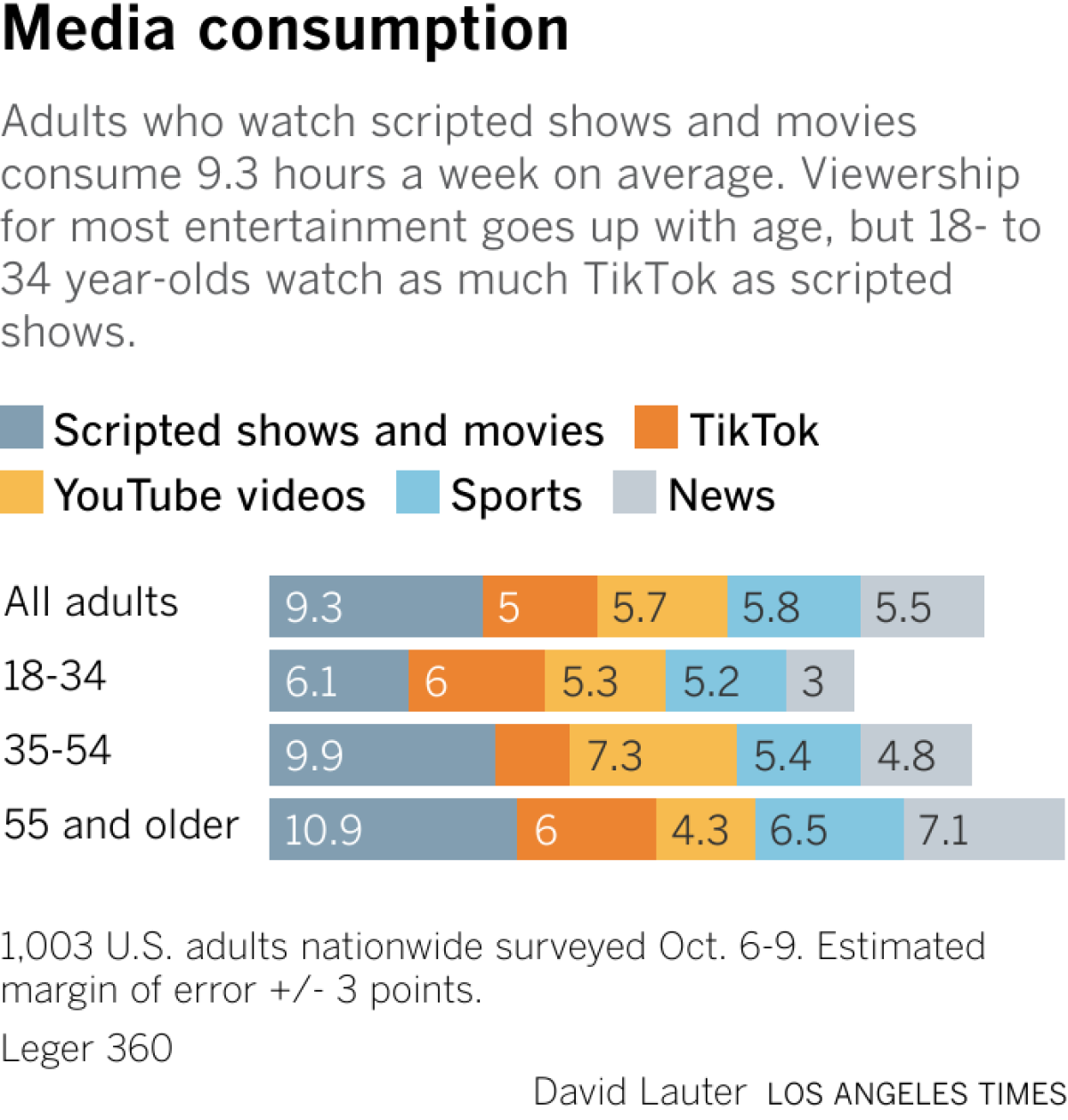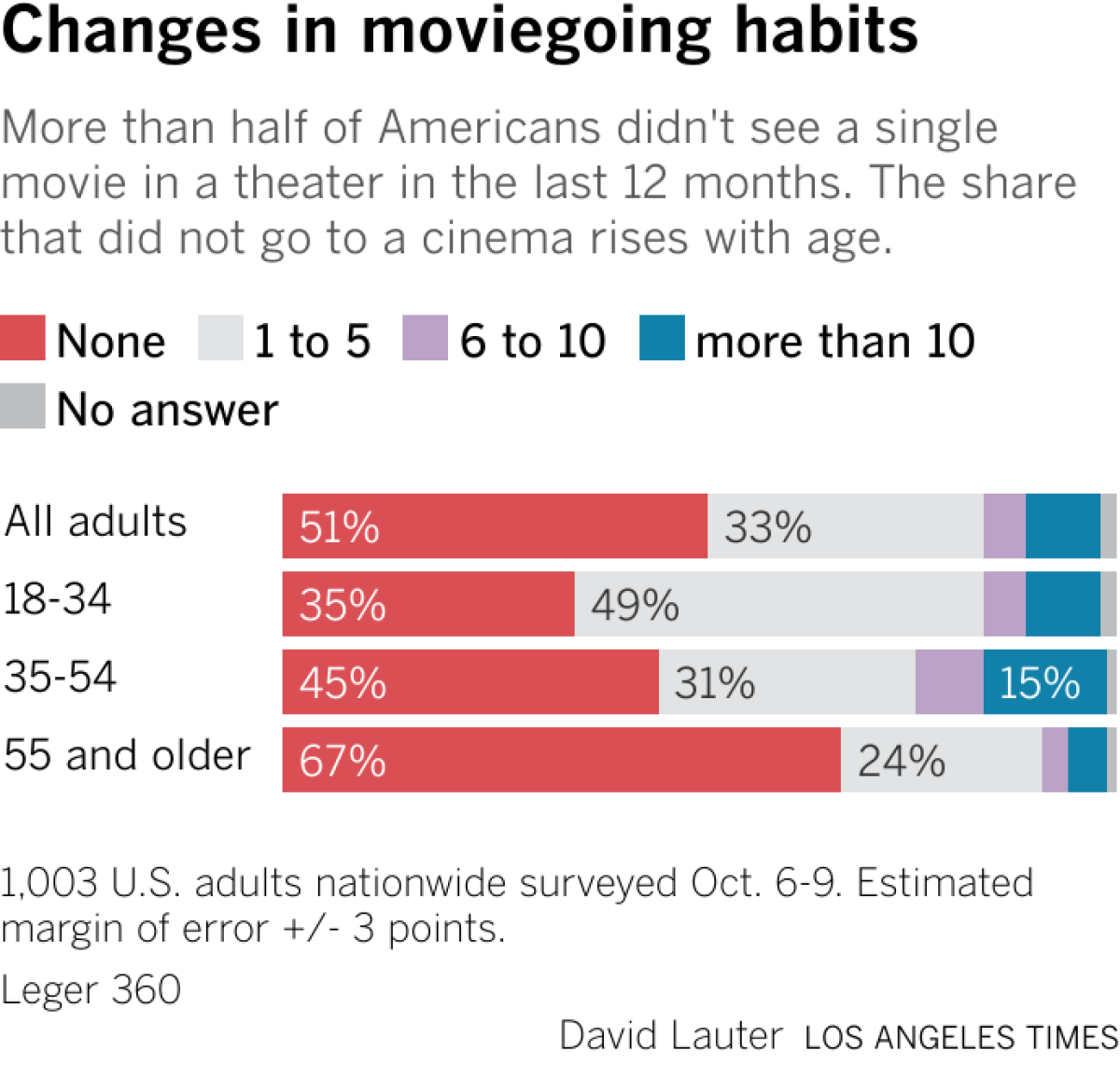As the Hollywood writers’ strike has come to a close and the actors’ walkout rages on, the American public continues to favor unions over studios, networks and streamers, a new poll for the Los Angeles Times finds.
The survey results arrived shortly before talks between the performers’ guild, SAG-AFTRA, and the Alliance of Motion Picture and Television Producers soured because of a dispute over how actors should be compensated from streaming. The latest wrinkle in negotiations has threatened to prolong the strike — along with its adverse effects on workers, the entertainment industry and the California economy — even further.
Three months into the SAG-AFTRA strike, 34% of Americans said they sided with actors in a survey conducted earlier this month for The Times by Leger, a Canada-based polling firm with experience in U.S. surveys. That number is similar to the 38% of respondents who said they supported striking actors and writers in a late-July poll conducted by Leger for The Times.
Meanwhile, support among the American public for the studios has stayed low and steady at 7%, while 29% of respondents said they sympathized with both sides equally. Thirty percent didn’t take a position.
The poll also asked Americans about the effects of the writers’ strike and their thoughts about its end. The Writers Guild of America and the AMPTP, the group that represents studios in contract negotiations, came to a resolution in late September after 148 days on the picket lines.
The survey asked if and how Americans’ viewing habits had shifted since the Hollywood strikes brought the industry to a near standstill. Because the work stoppages have slowed production and hampered studios’ promotional campaigns, there has been a marked decrease in new scripted programming and major movie releases.
About 7 in 10 Americans said they noticed the absence of new programming to at least some extent, although only about 1 in 4 said they noticed a lot.
Still, fewer than a quarter of Americans (22%) reported switching up their viewing habits to fill the void with more unscripted programming, while 44% reported no significant change in their routines.
About one third of respondents (34%) said they’d used the lull to catch up on old shows they hadn’t previously watched.
Despite the recent dip in fresh content, Americans still spend more time watching scripted programming than any other form of entertainment, with 78% of respondents viewing at least an hour of it per week, according to The Times/Leger poll. Those who reported consuming at least some scripted programming watched on average just over nine hours a week, the poll found.

The next most popular form of entertainment was sports, followed by YouTube videos, news, TikTok videos, nonscripted programs including game shows and reality TV, talk shows and videos on other social media platforms.
But viewing habits varied widely by age, the survey found, underscoring some of the generational challenges that Hollywood faces — even after the strikes end.
People ages 18 to 34, for example, reported spending roughly as much time watching videos on TikTok as they did watching scripted programming — an average of about six hours a week for each, the poll found. About half of the 18- to 34-year-olds said they were watching more videos on social media, including TikTok and YouTube, than two years ago.
Across all age groups, more than half of those surveyed (59%) said they viewed roughly the same amount of scripted programming as they did a couple of years ago. That total jumped to 67% among those over age 54.
For the most part, respondents said their social media consumption had remained constant through the strikes, with 51% of Americans reporting that they watched the same amount of videos on social media now as they did two years ago. But more Americans said their social media video consumption had increased (26%) than decreased (16%).
As actors continue to fight for greater shares of streaming revenue, more than two-thirds of Americans (69%) reported subscribing to at least one streaming service, while 28% said they didn’t subscribe to any. Most of those who didn’t subscribe cited either high costs or a lack of interest in consuming more content.
On the theatrical side, results were a tad more bleak. During a time when exhibitors are still recovering from the pandemic and strikes have delayed major big-screen releases, less than half of Americans (48%) said they’d seen at least one movie in theaters in the last year.
Thirty-three percent of moviegoers reported watching between one and five films at a cinema in the last year. The majority of respondents (51%) said they hadn’t seen a single picture in theaters in the last year. Moviegoing was highest among those ages 18 to 34, almost two-thirds of whom said they had seen at least one movie in a theater. Among those ages 55 and older, however, only one-third had seen even one.

Asked which side they believe prevailed in the writers’ strike, fewer than a fifth of respondents (18%) said they thought the writers had won more in the settlement, while just 9% believed that the studios had emerged victorious. Nineteen percent said they thought the writers and the studios had made comparable gains, while a majority of respondents (55%) declined to weigh in.
Overall, nearly half of Americans (46%) said the dual Hollywood strikes didn’t influence their perception of unions and the labor movement. However, 22% said that the actions taken by the WGA and SAG-AFTRA had positively influenced their opinions on the labor movement, while 12% said the work stoppages had had a negative effect on their perceptions. Twenty percent didn’t know how their opinions were swayed or declined to respond.
The Times/Leger poll surveyed 1,003 adult Americans from Oct. 6 to Oct. 9. The results have an estimated margin of error of roughly 3 percentage points in either direction.
Times staff writers Josh Rottenberg, Wendy Lee and Meg James contributed to this report.